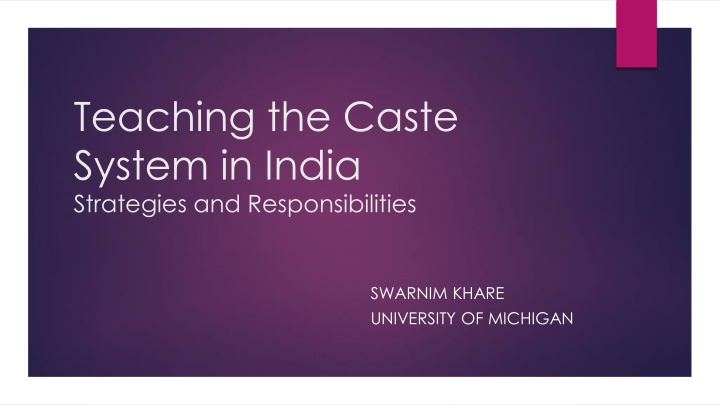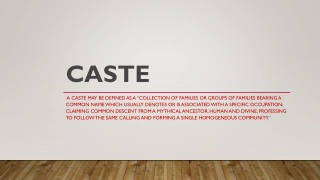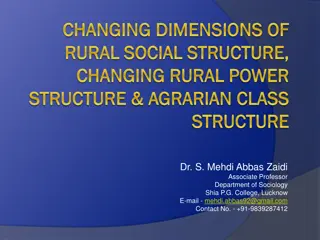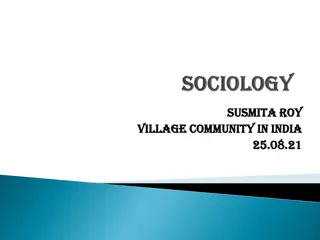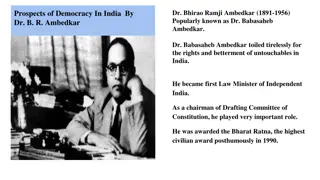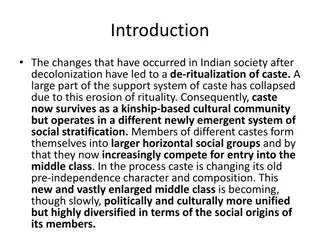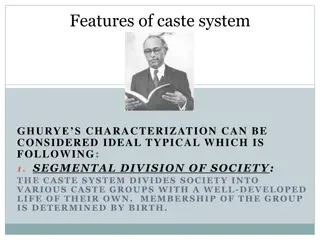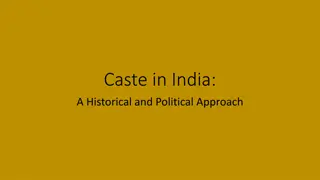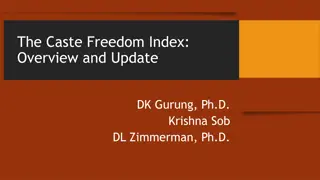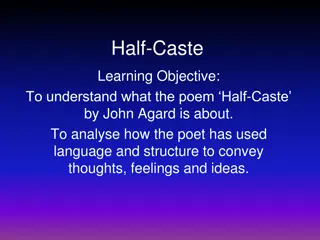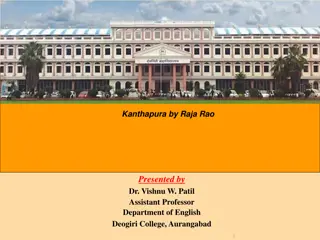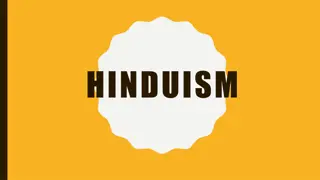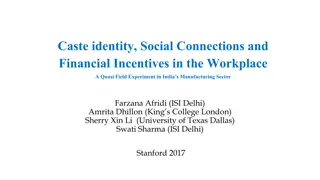Teaching the Caste System in India: Strategies and Responsibilities
The caste system in India is a system of graded inequality, shaping access to resources and opportunities. Understanding its complexities is crucial for addressing discrimination and promoting social equity. Explore the impact of caste in universities, identity markers, and the evolution of terms such as "Dalit." Strategies for inclusivity and empowerment are essential in education to combat inequality and promote a more just society.
Uploaded on Feb 17, 2025 | 0 Views
Download Presentation

Please find below an Image/Link to download the presentation.
The content on the website is provided AS IS for your information and personal use only. It may not be sold, licensed, or shared on other websites without obtaining consent from the author.If you encounter any issues during the download, it is possible that the publisher has removed the file from their server.
You are allowed to download the files provided on this website for personal or commercial use, subject to the condition that they are used lawfully. All files are the property of their respective owners.
The content on the website is provided AS IS for your information and personal use only. It may not be sold, licensed, or shared on other websites without obtaining consent from the author.
E N D
Presentation Transcript
Teaching the Caste System in India Strategies and Responsibilities SWARNIM KHARE UNIVERSITY OF MICHIGAN
What is the Caste System? A system of graded inequality in which castes are arranged according to an ascending scale of reverence and a descending scale of contempt. ~ Dr BR Ambedkar Also linked with access to resources and opportunities. Maintained through rules of endogamy & exogamy that control women s sexuality. Image from Equality Labs Survey of Caste Among South Asian Americans (2018)
Dalit To me, Dalit is not a caste. He is a man exploited by the social and economic traditions of the country Dalit Is a symbol of change and revolution -Gangadhar Pantawane the term Dalit is not only to be interpreted as the oppressed, but also as the proud, the defiant. As long as there is a group or groups who are victims of caste oppression, there must be a term to describe them and the literature they create to tell their stories. - Eleanor Zelliot
How do South Asians identify caste? Last name Food preferences The native hometown Religion Family and social affiliation
Routinized workings of caste in universities Overt Discrimination: not wanting to share hostel rooms with a person from lower caste, asking lower caste student to sweep the floor. Cultural Capital: English language competency, knowing how to navigate college or acquiring a holistic college experience. Social Capital: Social network and connections that help with everything from making friends to getting a job. Economic Capital: Access to resources for finding accommodation near college, participating in extra-curricular activities, buying books.
Go, Get Education! End misery of the oppressed and forsaken, You ve got a golden chance to learn So learn and break the chains of caste Throw the Brahmin s scriptures fast! ~ Savitribai Phule, Go, Get Education
Caste in the University As a result of this experience, Riya has internalized a strong narrative about her mediocrity. She is most definitely the sharpest and most hardworking student I ve encountered, yet, she intersperses any account of herself with references to how she s really very average. - Kriti Budhiraja (PhD student, Dept of Sociology, University of Minnesota)
A Dalit Woman in the Land of Goddesses Aruna Gogulamanda Her eyes two dry hollows bear silent witness To hundreds of deaths of her mothers, daughters, sisters Their dreams, respect and their bodies. Her calloused hands, her unkempt hair Her cracked heels, her wrinkled face Tell the tales of living through fears and years Of centuries and millennia of violations and deaths She was told That she was dirt, She was filth and In this sacred land of thousands of goddesses She is called a Dalit
